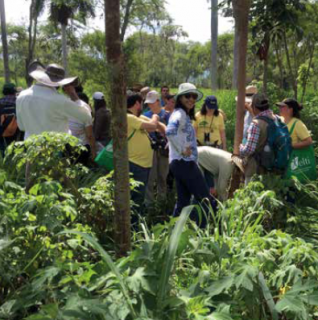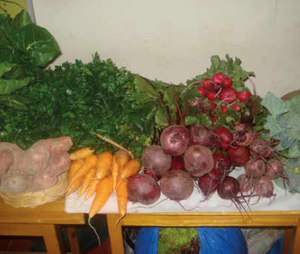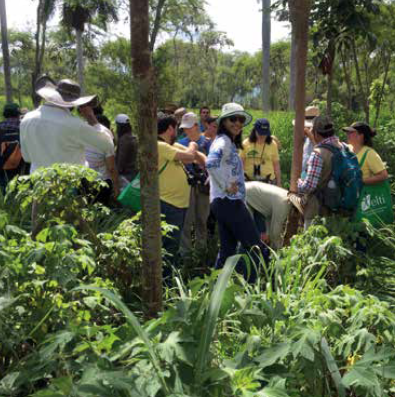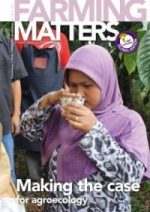This issue of Farming Matters explores how to demonstrate the critical role agroecology can play in responding to the challenges of our time.

Agroecology is ever more present in our food and farming system. In recent years, this approach to farming and food has gained visibility and recognition among food producers, scientists, citizens and policy makers alike. It is heartening that farmers increasingly take up agroecological practices, while both social movements and multilateral institutions such as the FAO develop policies on agroecology. However, the transition to a fundamentally different food system still has a long way to go.
It cannot be stressed enough that the way our food system is currently organised is incompatible with principles of equity, peace, biodiversity conservation and economic and environmental sustainability. Perverse subsidies supporting input intensive production systems and production chains that benefit a few agro-input providers and retailers, in the context of an urgent need to address climate change, biodiversity loss and malnutrition, point to the need for radical change. Here lies the potential of agroecology as a food system that can contribute to solutions for many of these challenges. But, while many successful agroecological examples exist, it is generally not yet regarded as the most effective food system. This tension is partly explained by the way society looks at impact. The multifaceted benefits of agroecology cannot be measured through the traditional ‘productivist’ lens.
Looking at progress
Understanding the impact of agroecology requires that we assess ‘progress’ through a different lens. In simple terms, starting from the notion that yield per hectare of one single crop is not the be all and end all measure of progress. New ways of measuring impact can highlight two important elements of our food systems. First, to show what is wrong with dominant ways of producing and distributing food. As Patrick Holden argues in his article on the ‘true cost of food’: if the environmental damage and the social costs of our current food system were actually accounted for, food in many places would not be so cheap. Second, to make explicit the various benefits from alternative systems such as agroecology. The impact of agroecology at any level, whether in the field, farm, community or across a nation or continent, is more adequately assessed in terms that reflect people’s well-being in all facets of life, including environmental sustainability. It requires a departure from oversimplified ratios that consider farming to be nothing more than conversion of material inputs (e.g. fertilizers, hectares) into commodities (e.g. yields). Our intention is not to downplay the importance of yield, but to place it in the context of many other, equally important, economic, social and environmental indicators. Shiney Varghese illustrates that this approach can provide decision makers with sufficient information to allocate resources in ways that generate the greatest positive impacts.
Monitoring change and impact

In many instances, ‘new’ ways of measuring impact of agroecology are not actually new. We can learn a lot from farmers who have been monitoring change and the impact of their decisions since time immemorial. The stories and perspectives in this issue are therefore grounded with farmer’s responses to the question, “how do you assess the impact of agroecology?” Their answers serve as a reminder of the richness in diversity of worldviews and that there is no one way to practice, let alone measure, the impact of agroecology.
Similarly, Jan Douwe van der Ploeg explains how peasants constantly ‘read’ their own and others’ farms to improve their on-farm natural and social resources. His call to recognise and learn from peasant’s ways of measuring impact is echoed in an interview with Clara Nicholls who calls for researchers assessing impact to work in a participatory way with farmers. Moreover, urban farmers in the city of Kaduna, Nigeria refer to indicators such as the increase in reliability and spread of income, their ability to send their children to school and consuming a greater variety of fruits and vegetables.
Further, agroecology transcends the farm, and for example, includes the development of new markets. This is a reminder of the challenge of measuring impact: capturing multiple dimensions such as farm resource use, health and citizens’ ability to choose and shape the way food is produced and; assessing impact holistically and at different levels such as fields, farms, communities, markets and regions. A story from Bolivia provides an example of measuring the impact of short production chains, taking into account farmers and consumers’ level of satisfaction as well as the access, availability, utilisation and stability dimensions of food security. Likewise, an experience in Burkina Faso shows how a holistic impact assessment can reveal nuances, such as equal distribution of benefits, that may otherwise go unnoticed.
Finally, even if there is more than enough captivating evidence that agroecology works, the power and influence vested in keeping the current food system in place should not be underestimated. For this reason, the ‘movement’ dimension of agroecology is especially relevant. Engaging in socio-political processes is paramount – of course armed with plenty of evidence and an appropriate lens through which to observe and value change.
Indicators for agroecology
Some things simply can’t be measured, nor is it feasible or practical to measure everything. Yet, in order to appreciate impact it is often useful and practical to use a repeatable measurement or observation. This is where indicators come in handy. Indicators, both quantitative and qualitative, can be seen as proxies for things that we cannot directly measure and also serve different purposes for different users. For example, in assessing soil quality, a researcher may consider soil organic matter a useful indicator while a farmer may prefer to assess soil quality with its colour, smell or feel. Factors such as the speed and ease of measurement, the level and time-frame of assessment and the sensitivity of the indicator are all considered when selecting indicators.


